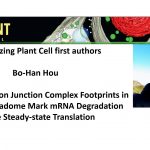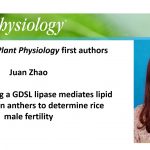Recognizing Plant Cell authors: Cheng-Yu Hou
Cheng-Yu Hou, co-first author of Widespread Exon Junction Complex Footprints in the RNA Degradome Mark mRNA Degradation Before Steady-state Translation
Current Position: Bioinformatician, Bioinformatics team of technology department, Sofiva Genomics Company, Taiwan
Education: Master of Science in Bioscience and Biotechnology at National Taiwan Ocean University, Taiwan
Non-scientific Interests: reading, jogging and digital drawing
Brief bio: When I was a high school student, I thought that it would be exciting if I could integrate my two interests, biology and computers, to discover something interesting or meaningful. After I earned my master degree from National Taiwan Ocean University, I joined Dr. Ho-Ming Chen’s Lab in Academia Sinica. Although I had no prior experience of bioinformatics, under the guidance of Dr. Chen, I quickly developed the skills in mining, visualization and interpretation of next-generation sequencing data. First, we revealed that truncated RNA molecules could be footprints of RNA binding proteins (Hou et al., BMC Genomics, 2014). Given that ribosomes represent a large proportion of RNA binding proteins, we next hypothesized that ribosomes leave footprints in the RNA degradome and demonstrated the use of RNA degradome data in the study of ribosome stalling (Hou et al., Plant Cell, 2016). In our current work, we further showed that the RNA degradome also contains exon junction complex footprints which can serve as markers for inferring mRNA degradation before steady-state translation. These findings expand the applications of RNA degradome data to ribosome stalling and nonsense-mediated mRNA decay. As I look back on the days, the skills and experience that I gained in Dr. Chen’s Lab pave the way towards my career in bioinformatics, which is satisfying my dream of answering biological questions with computers.




